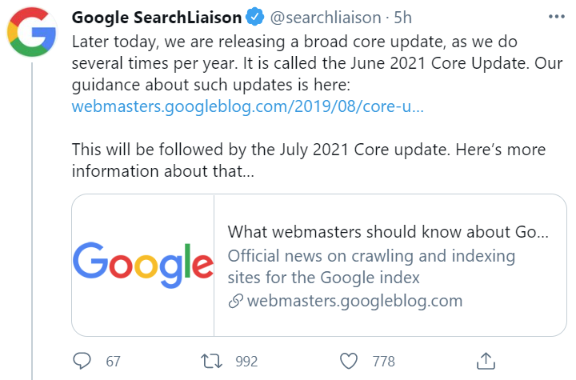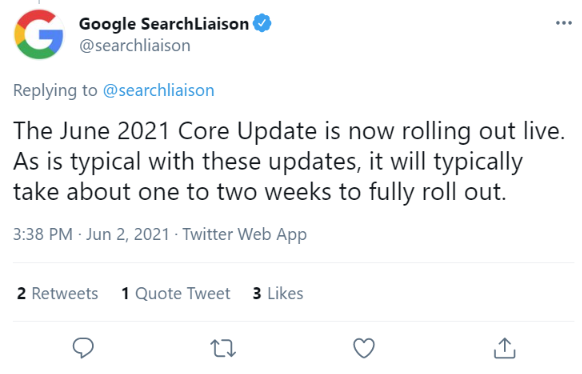In today’s news, the latest Google broad core update is rolling out. Google’s Danny Sullivan announced this update on Twitter (more on this below).
However, there is more than one aspect to this update.
Firstly, it will be released in two batches: one in June and the other in July.
One can’t help but wonder how this relates to the page experience update that’s coming in mid-June.
Historically, Google has released core updates every few months, usually relatively close to the end of each quarter: in March, May/June, August/September and December. It’s been a long time since the last core update was released back in December 2020.
Earlier on in 2020, the regularity of updates began to change from a quarterly cadence to being more spread out.
The phased release of Google core updates is not that surprising, given that a major underlying function of page experience (Core Web Vitals) is being rolled out in mid-June.
Here is what Google had to say about the update:
What You Should Expect
Most core updates do result in fluctuations in traffic and rankings—that’s a given. The things that you should be most concerned about are:
- extraordinarily low quality content compared to competitors;
- low-quality technical SEO implementation overall;
- matching of user intent signals (or not); and
- the overall quality of the website itself.
Here’s how Google explained what’s important to pay attention to after a core update:
One way to think of how a core update operates is to imagine you made a list of the top 100 movies in 2015. A few years later in 2019, you refresh the list. It’s going to naturally change. Some new and wonderful movies that never existed before will now be candidates for inclusion. You might also reassess some films and realize they deserved a higher place on the list than they had before.
The list will change, and films previously higher on the list that move down aren’t bad. There are simply more deserving films that are coming before them.”
What You Should Focus On
Google explains that the most important factors you should focus on when your site has been hit by a core update include focusing on your content’s:
- quality;
- expertise; and
- presentation and production.
Let’s take a closer look at these factors, direct from Google:
Content and Quality Questions
- Does the content provide original information, reporting, research or analysis?
- Does the content provide a substantial, complete or comprehensive description of the topic?
- Does the content provide insightful analysis or interesting information that is beyond obvious?
- If the content draws on other sources, does it avoid simply copying or rewriting those sources and instead provide substantial additional value and originality?
- Does the headline and/or page title provide a descriptive, helpful summary of the content?
- Does the headline and/or page title avoid being exaggerating or shocking in nature?
- Is this the sort of page you’d want to bookmark, share with a friend, or recommend?
- Would you expect to see this content in or referenced by a printed magazine, encyclopedia or book?
Expertise Questions
- Does the content present information in a way that makes you want to trust it, such as by using clear sourcing, evidence of the expertise involved, and background about the author or the site that publishes it, such as through links to an author page or a site’s About page?
- If you researched the site producing the content, would you come away with an impression that it is well-trusted or widely-recognized as an authority on its topic?
- Is this content written by an expert or enthusiast who demonstrably knows the topic well?
- Is the content free from easily-verified factual errors?
- Would you feel comfortable trusting this content for issues relating to your money or your life?
Presentation and Production Questions
- Is the content free from spelling or stylistic issues?
- Was the content produced well, or does it appear sloppy or hastily produced?
- Is the content mass-produced by or outsourced to a large number of creators, or spread across a large network of sites, so that individual pages or sites don’t get as much attention or care?
- Does the content have an excessive amount of ads that distract from or interfere with the main content?
- Does content display well for mobile devices when viewed on them?
Comparative Questions
- Does the content provide substantial value when compared to other pages in search results?
- Does the content seem to be serving the genuine interests of visitors to the site or does it seem to exist solely by someone attempting to guess what might rank well in search engines?
Google’s developer documentation has much more to say about specific Google guidelines and recommendations on how to deal with core updates on your own site.
Our SEO Insights
Based on the timing and the execution of of these core updates, we think these updates may contain another dimension that relates to page experience. In most cases, page experience also falls into technical SEO, so this isn’t exactly a new idea.
But the new aspect could be how page experience is rolled into the Google core updates.
Our guess: The June core update might be running concurrently with the core web vitals update being released in mid-June. This would make sense: there are two parts to the core updates, and Google says that:
At this point this is all just speculation, but given what we know so far about the core update, this does seem plausible.
The Darker Side of Google Core Updates
Google talks about core updates casually and says things like page experience isn’t going to be “much of a big deal.”
However, it can be a huge deal if a business loses 50 percent or more of its traffic. If that happens, other things have to happen.
When that traffic is driving conversions and people are no longer buying a product or service, then the business loses income from the core updates.
If income is lost, they can’t pay employees, and employees have to get cut.
We disagree with Google’s stance on the issue in some ways. While we do agree that some aspects of a core update may not exactly be earth-shattering for some webmasters, for other webmasters, they can be devastating.
This is where we think that some of what Google says should be taken with a grain of salt, and only you will know for certain how the update may affect your industry.
More of your own judgment on your particular site and situation is needed to really assess where you must go next, and what you need to look into.
Core updates affect each niche differently, and just because one site was hit by an update doesn’t mean your site will be hit in exactly the same way.
At the end of the day, it all boils down to who is hit the hardest, and how much of a path to recovery they can see.
If that path is invisible or there is a lot of hard work involved, at that point some companies may opt for the nuclear approach to cut costs.
The Faster You Fix the Issues, The Sooner You Can Realize the Benefits of Your Repairs
When it comes to core updates, nothing is guaranteed. You can lose rankings and traffic, or you could experience improvement.
If you find that you’re in the situation where your site is hit by this update, first, we recommend assessing your content and identifying where the major technical issues are (crawling, indexing, technical errors, page speed, page experience, core web vitals), then take a look at the content issues that Google also outlines (including E-A-T, or expertise, authoritativeness, and trust).
The one critical part of E-A-T we must mention at this juncture is that it’s not part of the algorithm. It’s part of Google’s quality raters guidelines.
These guidelines are for human reviewers that work in a different department than Google’s search. While they may provide a framework you can use to assess things from an SEO perspective, it’s important to realize that E-A-T is not actually part of SEO (the raters guide is not currently programmed into the actual search algorithms).
When you find technical issues, you want to fix them as soon as possible. You don’t know when Google is going to change the cadence of core updates, or if they will always release core updates on the same schedule.
For smaller sites (500 pages or less) we recommend a regular site audit schedule where you can find and repair issues on a regular basis (perhaps once a month).
For larger sites (100,000 pages or more) we still recommend a regular auditing schedule. With a regular auditing schedule, you can find issues and repair them sooner than you would if you audited your site once a year. It may be feasible for some sites to implement a once a month schedule. For others, once a quarter could be best.
Why do we recommend this for larger sites? Larger sites tend to have much more to lose in terms of rankings and traffic. Losing that ground you have gained could result in significant consequences later on, and it could be harder to get back to where you started than maintaining your existing trajectory.
At the end of the day, it will depend on the team you have in place and the resources you have access to.
One thing we do know: the quicker you find and repair these issues, the faster you may be able to realize the benefits of your repairs.
Image Credits
Screenshots by author / May 2021














